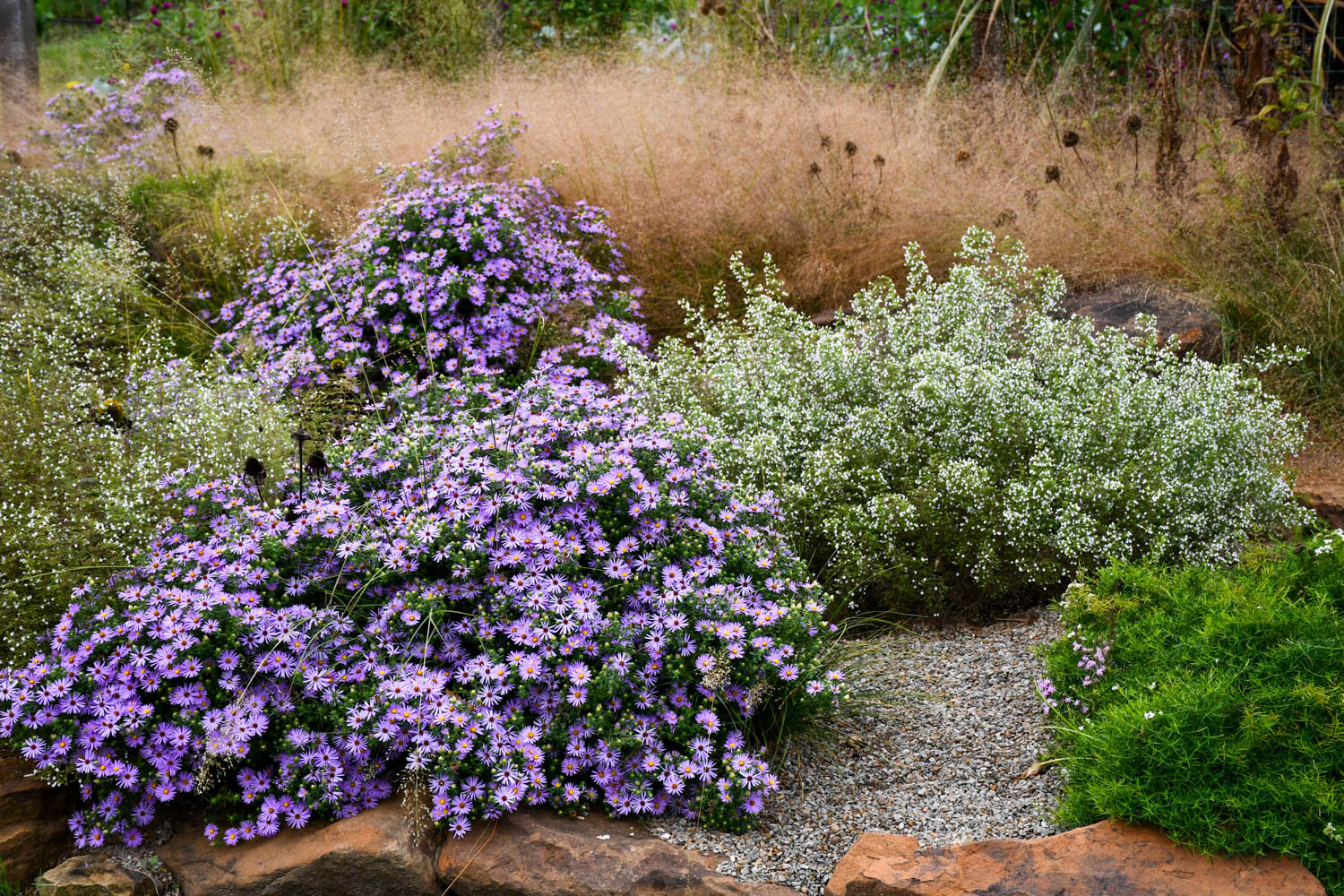I’ve been waiting for this moment since we planted the gravel garden back in April. Symphyotrichum oblongifolium ‘Raydon’s Favorite’ has come into bloom, and it is spectacular. This aromatic aster glows amongst the haze of Muhlenbergia reverchonii and the white dust of Calamintha nepeta subsp. nepeta to beckon the end of the year.
A bit of repetition with Symphyotrichum oblongifolium ‘Raydon’s Favorite’ and Calamintha nepeta subsp. nepeta.
Its hard to convey to students what this plant will do in autumn no matter how animated you get in saying, “IT WILL BE COVERED IN PURPLE BLOOMS,” in front of some non-descript foliage. And, spelling the name Symphyotrichum oblongifolium ‘Raydon’s Favorite’ on a plant id exam can be a bit of a turn off I guess. But, after it puts on a show, ‘Raydon’s Favorite’ consistently becomes one of their favorites, too. Perhaps because witnessing the transformation is amazing. One week its another green mound in the landscape, and then the next its smothered in blooms.
For us in east Texas, bloom time lasts around 6 weeks, which is enough time to help cement the name into their heads. This year the asters were a bit later. I’ve depended on them to start flowering toward the end of September, but they all seemed sluggish to get going.
A spray of Muhlenbergia reverchonii erupts from the purple rays and yellow disks of Symphyotrichum oblongifolium ‘Raydon’s Favorite’.
I began wondering from where my original plant came. If I remember correctly, I picked up my first ‘Raydon’s Favorite’ attending the 2007 Tennessee Master Gardener Conference in Kingsport, TN. Some speaker highly recommended it, and once I had it in the ground I could see why. Each fall, it was covered with hundreds of purple rays and yellow disks. This aster spread in my parent’s garden, so much so that I was able to get starts to bring to Texas a few years ago. I do wish that I could say mine at home look as good as these in the gravel garden at school, but I have the voles to blame for their haggard appearance.
The gravel garden planting is a wonderful entrance for the Sprout garden. Even more so now that ‘Raydon’s Favorite’ is in flower.
I also began to wonder where this wonderful cultivar originated. I reached out to Allen Bush. I happened to see online this week he put the name ‘Raydon’s Favorite’ on this selection. I met Allen in 2007 at the Perennial Plant Association in Columbus, Ohio, probably around the same time that my ‘Raydon’s Favorite’ was just getting rooted in well, and he has been a good friend to this day. A phone call later we were swapping aster stories.
Allen said he named this aster after Raydon Alexander of San Antonio, TX. Raydon had seen this aster around the south as a passalong plant, and he shared it with Allen to evaluate and grow. Raydon said he thought that it was a form of Aster × frikartii, but the morphology wasn’t right. Once in Allen’s hands, he had an aster expert key it to a form of Symphyotrichum oblongifolium. However, this selection was more compact than the typical species, which warranted its horticultural use. With Allen’s help it got around, so much so that the Garden Club of America named it Plant of the Year in 2016. Allen added that while sometimes you’ll see the variety name angustatus on it, he doesn’t think that it holds much nomenclatural merit.
We talked about how well our plants were performing in the gravel garden. Allen said he thinks that the grit is closer to the actual habitat than just regular garden soil. He is used to seeing aromatic aster in Kentucky thriving in limestone road cuts and xeric outcrops. He cuts his back in mid-June to help prevent flopping.
Before saying goodbye, we both chatted about how we needed to try ‘October Skies’, an even tighter aster and two weeks earlier flowering than ‘Raydon’s Favorite’.
Don’t you just love how tight these purple mounds are?
But, no matter what new asters come out, ‘Raydon’s Favorite’ is still one of Jared’s favorites, and I can’t imagine a world without it. So, thanks Allen and Raydon for sharing this wonderful plant with all of us.




